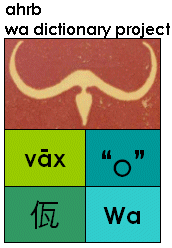
|
Wa Numbering SystemsUpdated 2005.01.27The Wa people have two main sets of numbers, one native and one borrowed from Tai (Shan), which are used separately and mixed together, depending on the size of the number, the context, and the region where used. These are enumerated in the chart of number correspondences. The following description is based on Zhou Zhizhi 周植志 and Yan Qixiang 颜其香, Wayu jianzhi 佤语简志, pp. 40-50. Cardinal numbersThe Parauk dialect uses the numbers borrowed from Tai for all numbers between 30 and 99; the Va dialect uses the borrowed Tai numbers only for the 10's and from 31 to 39 etc. uses native numbers for the one's place; the Ava dialect uses various morphological processes to form the multiples of 10 from 20 to 90: 1) alternation of the vowel between /a/ and /uɛ[epsilon]/ to form 20 and 30; 2) [to be continued]. The numbers borrowed from Tai are also usually used for small weights using the traditional system of taels or liang (Wa róng, equal to 38-50 grams) and ticals or qian (Wa thei, equal to 3-5? grams). Ordinal numbersOrdinal numbers in Wa (of the type "the first," "the second," etc.) are formed by simply placing the cardinal number after the noun which it modifies, as in the syntactic ordinal formation in English ("book 1," "day 2," etc.). E.g.,
See chart of number correspondences (working draft, updated 2005-06-23). Data in the chart comes from many sources, including the following (for full citations, see Wa bibliography):
Discrepancies in the data may be due to regional variation, to lapses in cultural memory, to transcription errors in the sources used, or they may simply be mistakes. |

